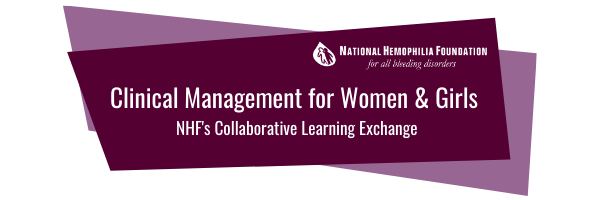
NBDF’s Collaborative Learning Exchange series on “Emerging Clinical Issues – Improved Clinical Management of Women and Girls Diagnosed with a Bleeding Disorder" was intended for physicians (MD/DO), physician assistants, nurse practitioners, and other clinicians with prescriptive authority for individuals living with von Willebrand Disease, hemophilia A, or hemophilia B.
BACKGROUND:
Inherited bleeding disorders are under-recognized as causes of bleeding in women, girls, and people with the propensity to menstruate (WGPPM). Establishing the correct diagnosis of these disorders has important implications for management of bleeding, recommendations for invasive procedures, pregnancy and delivery management, and family planning and testing.
Healthcare providers and particularly medical prescribers, need to be aware of and understand how to interpret the results of diagnostic testing for WGPPM. It is also essential that their knowledge encompasses the therapeutic developments and life cycle implications that are unique for WGPPM for managing a bleeding disorder, including menstruation, pregnancy, delivery, and menopause. A robust application of the shared decision-making model is also critical so that providers are prepared to discuss the possible risks and benefits of care options with their patients.
NHF, along with a group of key providers, developed this series to create opportunities for prescribers to discuss the unique clinical implications for diagnostics and current treatment decision-making and management for bleeding disorders or in specific patient scenarios for WGPPM.
The following activities were held as live virtual interactive events in late 2022 and 2023.
"VWD Diagnostic Testing Challenges for Women, Girls, and People with the Propensity to Menstruate (WGPPM)" was held live on 11/17/22.
Insights on the challenges to diagnosis of von Willebrand Disease (VWD) in people with the propensity to menstruate were given. Currently available tests and newer VWD assays were reviewed and the pre-analytic variables that impact coagulation test results for WGPPMs with family history and/or symptoms of a bleeding disorder were discussed further.
Please leave your feedback after completing this webinar.
"Provider and Patient Communications for Shared Decision-Making when Providing Healthcare for Women, Girls, and People with the Propensity to Menstruate (WGPPM)" was held live on 1/24/23.
A comparison of ‘shared decision-making’ (SDM) models for patient-clinician communication was presented. Barriers to employing SDM in clinical practice were discussed, particularly with identifying where individual bias exists. Insights were shared on how clinicians could incorporate key components of SDM into their treatment conversations with WGPPM of different ages.
Please leave your feedback after completing this webinar.
"VWD Treatment Across the Lifespan for Women, Girls, and People with the Propensity to Menstruate (WGPPM)" was held live on 4/13/23.
A summary of VWD treatment needs for WGPPM across their lifespans was presented, including treatment options for heavy menstrual bleeding and perioperative management for cardiovascular procedures. Gender-affirming care considerations in the context of VWD were also discussed.
Please leave your feedback after completing this webinar.
"Clinical Challenges in the Management of Pregnancy and Delivery in Women, Girls, and People with the Propensity to Menstruate (WGPPM)" was held live on 5/11/23.
We reviewed the maternal implications of an underlying bleeding disorder along with the risk of life-threatening bleeding at time of delivery and post-partum for WGPPM. The key components to hemostatic evaluation prior to delivery and management options antepartum were covered, including appropriate use of epidural analgesia for WGPPM with underlying bleeding disorders.
Please leave your feedback after completing this webinar.
Please note: Each of these events in their recorded formats are no longer available
for CME/CE credit.

